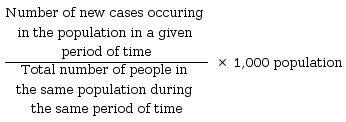Incidence rate
The incidence rate is a very useful measure of the frequency of new cases of a disease or disorder occurring in your community over a given period of time (usually a year, month, or a week during new outbreaks). Calculating the incidence rate at intervals enables you to assess whether a particular health condition is improving or getting worse in your community over time.
The incidence rate is calculated using a simple formula, which has a numerator (the number above the line in a fraction) and a denominator (the number below the line in a fraction). To calculate the incidence rate for a particular disease/disorder, you need to know:
- The total number of new cases of that condition seen in a particular population (country, region, town, village) during the period you are interested in (this is the numerator)
- The total number of people in the population you are interested in, during the same period (this is the denominator).
You divide the numerator by the demoninator and multiply the result by 1,000. This is the traditional way of expressing an incidence rate, as the number of new cases of the disease/disorder per 1,000 people in the population. The formula is given in the box below.
Formula for calculating the incidence rate of a disease/disorder
Incidence rate per 1,000 population =

Imagine that there were 50 new cases of typhoid fever in your community during June 2014. The total population of your community was 5,000 people. Calculate the incidence rate of typhoid in your community in that month.
The number of new cases of typhoid = 50 and the total population = 5,000.
Divide 50 by 5,000 and multiply the result by 1,000 to calculate the incidence rate per 1,000 people in this population:
Therefore, the incidence rate of typhoid in June 2014 in this community was 10 new cases in every 1,000 people in the population.